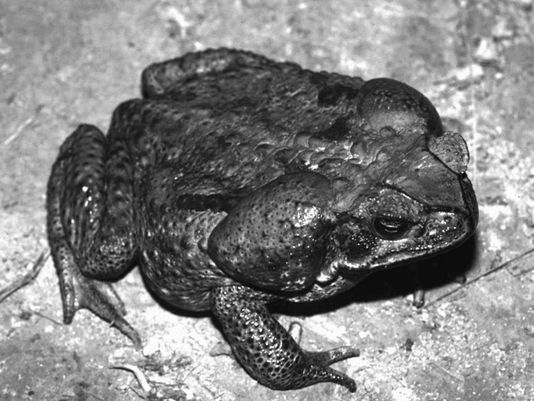FORT MYERS, Fla. — Sarah Hulke-Ehorn didn't want to become an expert on bufo toads.
The invasive critters literally jumped their way into her life nearly a year ago, when one of her Yorkies snatched up what turned out to be a deadly toad.
"She thought she was protecting us," Hulke-Ehorn said while sitting on her lanai. "She came out from under the smoker with its head in her mouth, and she’s killed rats and bunnies. That’s what they were bred for."
Next, the dog, a 3-year-old named Daisy Mae, started convulsing at their home in south Fort Myers.
"She started having seizures, and right as we pulled into the (veterinarian office) she died in my lap," she said. "It was violent. The noises she was making, it was horrible. We had been killing them prior to that. We knew about the toads. (But at the time) I was afraid of my own backyard because they were out there."
Nowadays Hulke-Ehorn is like a growing number of Florida residents, people who are adapting their daily lives to battle the toxic invasive species.
Monday will be the one-year anniversary of Daisy Mae's death.
During that time, Hulke-Ehorn's life has changed: her daily routine includes looking for the bufo (or cane) toads every morning and toad-proofing their property. She and her husband have used corrugated metal sheets around the yard, which seems to keep them from hopping through the fence.
The couple have five Yorkies.
The toads have been in Florida since the 1950s when they were accidentally released from the stock of a pet dealer at the Miami airport in 1955, according to the University of Florida Wildlife Extension.
They're the largest member of the frog family on the planet and are adept at reproducing in man-made lakes and canals, which can be found throughout most of the Sunshine State.
These creepy critters also compete with and eat native frogs and toads.
Their skin secretes a toxin when the toads are attacked, and that toxin can be deadly.
"These toads are nasty guys, and they’re getting worse and worse," her husband, Dan Ehorn, said. "I put that corrugated fence down and they’re keeping them out. Then they started coming in another part of the fence and I had to put paneling down. This weekend I’m building (another) fence."
Reagan Terry, marketing director for Animal Specialty Hospital of Florida in Naples, first learned about the toads after she moved here from New York.

"I had been working in the business for almost a decade before moving here and I didn’t even know these bufo toads existed," she said. "Then one evening I went to dinner and I had my dogs outside and I (went inside briefly) and came back and one of my little girls had grabbed one."
Right away, she saw the signs of a poisoning.
"As soon as she came in she was pawing at her mouth and hyper-salivating and I knew to rinse out her mouth with a hose," Terry said. "And I took her to the emergency vet. (But) we’ve seen pets who haven’t fared as well."
Pawing at the mouth and frantic, disoriented behavior are the first signs of bufo toad poisoning, according to the University of Florida.
Seven-year-old Tippy May, a basset hound, lived. But like Terry noted, some don't.
"If we get a handle on it quick enough we can most of the time help out and typically they can have a happy ending if the owners know to the rinse out the mouth and bring them to the hospital," Terry said. "But we've been hyper-vigilant and maybe even overprotective. We're still very, very cautious."
Veterinarians recommend that pet owners who suspect that their dog has bitten a toad use a hose to rinse out their mouths.
"Bufo toads can secrete a defensive toxin dangerous to dogs, cats and other animals if ingested," Diane Hirth, with the Florida Fish and Wildlife Conservation Commission, wrote to The News-Press in an email. "If you believe a pet has ingested or bitten a bufo toad, wash the toxins forward out of the mouth using a hose for 10 minutes, but be careful not to let water down the animal’s throat and get it to the vet."
The toxin also can cause skin and eye irritation in humans, so wash any area in contact with a toad with warm soapy water. It could be very dangerous if a child ingests or bites one. At that point, go to the hospital.
What should you do if you find a bufo toad?
The University of Florida says these toads can be humanely euthanized by rubbing or spraying a 20% benzocaine or sunburn spray (don't use the 5% lidocaine type) on its belly. The toad will become unconscious in a few minutes. Put it in a sealed plastic bag and place it in the freezer for 24 to 48 hours and then dispose of the body.
Hulke-Ehorn said she has little empathy for the invasive animals. Her toad-catching kit includes a reacher-grabber tool, a small frog gig and a bucket for storing what she catches or kills.
"I’m not going to stick them in the freezer," she said. "My dog didn’t die humanely, so I don’t have a problem gigging them."
Bufo, or cane toad
Rhinella marinus
• Found originally in Central and South America, the species was introduced into the United States in the 1950s through the farming industry. The toads were released in sugar fields with the hopes that they'd eat pests.
• They've since spread across much of Florida and have become a permanent part of the ecology.
• This is the largest species of frog on the planet, growing to 9.5 inches.


